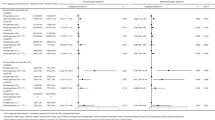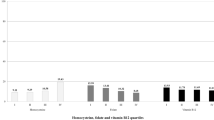Abstract
Folate deficiency and maternal smoking are strong risk factors for placental abruption. We assessed whether the reduced folate carrier [NM_194255.1: c.80A→G (i.e., p.His27Arg)] (RFC-1) polymorphism was associated with placental abruption, and evaluated if maternal smoking modified the association between plasma folate and abruption. Data were derived from the New Jersey-Placental Abruption Study—a multicenter, case-control study of placental abruption (2002–2007). Maternal DNA was assayed for the RFC-1 c.80A→G polymorphism using a PCR-dependent diagnostic test. Maternal folate (nmol/l) was assessed from maternal plasma, collected immediately following delivery. Due to assay limitations, folate levels at ≥60 nmol/l were truncated at 60 nmol/l. Therefore, case–control differences in folate were assessed from censored log-normal regression models following adjustment for potential confounders. Distribution of the mutant allele (G) of the RFC-1 c.80A→G polymorphism was similar between cases (52.3%; n = 196) and controls (50.5%; n = 191), as was the homozygous mutant (G/G) genotype (OR 1.1, 95% CI 0.6–2.2). In a sub-sample of 136 cases and 140 controls, maternal plasma folate levels (mean ± standard error) corrected for assay detection limits were similar between placental abruption cases (63.6 ± 5.1 nmol/l) and controls (58.3 ± 4.7 nmol/l; P = 0.270), and maternal smoking did not modify this relationship (interaction P = 0.169). We did not detect any association between the RFC-1 c.80A→G polymorphism and placental abruption, nor was an association between plasma folate and abruption risk evident. These findings may be the consequence of high prevalence of prenatal multivitamin and folate supplementation in this population (over 80%). It is therefore not surprising that folate deficiency may be rare and that the RFC-1 c.80A→G polymorphism is less biologically significant for placental abruption.

Similar content being viewed by others
References
Alperin JB, Haggard ME, McGanity WJ (1969) Folic acid, pregnancy, and abruptio placentae. Am J Clin Nutr 22:1354–1361
Ananth CV, Cnattingius S (2007) Influence of maternal smoking on placental abruption in successive pregnancies: a population-based prospective cohort study in Sweden. Am J Epidemiol 166:289–295
Ananth CV, Savitz DA, Luther ER (1996a) Maternal cigarette smoking as a risk factor for placental abruption, placenta previa, and uterine bleeding in pregnancy. Am J Epidemiol 144:881–889
Ananth CV, Savitz DA, Williams MA (1996b) Placental abruption and its association with hypertension and prolonged rupture of membranes: a methodologic review and meta-analysis. Obstet Gynecol 88:309–318
Ananth CV, Berkowitz GS, Savitz DA, Lapinski RH (1999a) Placental abruption and adverse perinatal outcomes. JAMA 282:1646–1651
Ananth CV, Smulian JC, Vintzileos AM (1999b) Incidence of placental abruption in relation to cigarette smoking and hypertensive disorders during pregnancy: a meta-analysis of observational studies. Obstet Gynecol 93:622–628
Ananth CV, Oyelese Y, Srinivas N, Yeo L, Vintzileos AM (2004) Preterm premature rupture of membranes, intrauterine infection, and oligohydramnios: risk factors for placental abruption. Obstet Gynecol 104:71–77
Ananth CV, Oyelese Y, Yeo L, Pradhan A, Vintzileos AM (2005) Placental abruption in the United States, 1979 through 2001: temporal trends and potential determinants. Am J Obstet Gynecol 192:191–198
Ananth CV, Getahun D, Peltier MR, Smulian JC (2006) Placental abruption in term and preterm gestations: evidence for heterogeneity in clinical pathways. Obstet Gynecol 107:785–792
Ananth CV, Elsasser DA, Kinzler WL, Peltier MR, Getahun D, Leclerc D, Rozen RR (2007a) Polymorphisms in methionine synthase reductase and betaine-homocysteine S-methyltransferase genes: risk of placental abruption. Mol Genet Metab 91:104–110
Ananth CV, Peltier MR, Chavez MR, Kirby RS, Getahun D, Vintzileos AM (2007b) Recurrence of ischemic placental disease. Obstet Gynecol 110:128–133
Ananth CV, Peltier MR, De Marco C, Elsasser DA, Getahun D, Rozen R, Smulian JC (2007c) Associations between 2 polymorphisms in the methylenetetrahydrofolate reductase gene and placental abruption. Am J Obstet Gynecol 197:385e1–385e7
Bissonnette R, Treacy E, Rozen R, Boucher B, Cohn JS, Genest J Jr (2001) Fenofibrate raises plasma homocysteine levels in the fasted and fed states. Atherosclerosis 155:455–462
Chango A, Emery-Fillon N, de Courcy GP, Lambert D, Pfister M, Rosenblatt DS, Nicolas JP (2000) A polymorphism (80G → A) in the reduced folate carrier gene and its associations with folate status and homocysteinemia. Mol Genet Metab 70:310–315
Cnattingius S (1997) Maternal age modifies the effect of maternal smoking on intrauterine growth retardation but not on late fetal death and placental abruption. Am J Epidemiol 145:319–323
Cox DR, Oakes D (1984) Analysis of survival data. Chapman & Hall, New York
De Marco P, Calevo MG, Moroni A, Arata L, Merello E, Cama A, Finnell RH, Andreussi L, Capra V (2001) Polymorphisms in genes involved in folate metabolism as risk factors for NTDs. Eur J Pediatr Surg 11(Suppl 1):S14–S17
Giugliani ER, Jorge SM, Goncalves AL (1985) Serum vitamin B12 levels in parturients, in the intervillous space of the placenta and in full-term newborns and their interrelationships with folate levels. Am J Clin Nutr 41:330–335
Hall MH (1972) Folic acid deficiency and abruptio placentae. J Obstet Gynaecol Br Commonw 79:222–225
Hibbard BM (1964) The role of folic acid in pregnancy; with particular reference to anaemia, abruption and abortion. J Obstet Gynaecol Br Commonw 71:529–542
Hibbard BM (1975) Folates and the fetus. S Afr Med J 49:1223–1226
Hibbard BM, Hibbard ED (1963) Aetiological factors in abruptio placentae. Br Med J 2:1430–1436
Hintze J, Nelson RD (1998) Violin plots: a box-plot density trace synergism. Am Stat 52:181–184
Hourihane B, Coyle CV, Drury MI (1960) Megaloblastic anaemia of pregnancy. J Ir Med Assoc 47:1–6
Kramer MS, Usher RH, Pollack R, Boyd M, Usher S (1997) Etiologic determinants of abruptio placentae. Obstet Gynecol 89:221–226
Kyrklund-Blomberg NB, Gennser G, Cnattingius S (2001) Placental abruption and perinatal death. Paediatr Perinat Epidemiol 15:290–297
McDonald SD, Perkins SL, Jodouin CA, Walker MC (2002) Folate levels in pregnant women who smoke: an important gene/environment interaction. Am J Obstet Gynecol 187:620–625
Menon MK, Sengupta M, Ramaswamy N (1966) Accidental haemorrhage and folic acid deficiency. J Obstet Gynaecol Br Commonw 73:49–52
Morin I, Devlin AM, Leclerc D, Sabbaghian N, Halsted CH, Finnell R, Rozen R (2003) Evaluation of genetic variants in the reduced folate carrier and in glutamate carboxypeptidase II for spina bifida risk. Mol Genet Metab 79:197–200
Nilsen RM, Vollset SE, Rasmussen SA, Ueland PM, Daltveit AK (2008) Folic acid and multivitamin supplement use and risk of placental abruption: a population-based registry study. Am J Epidemiol 167:867–874
Piyathilake CJ, Macaluso M, Hine RJ, Richards EW, Krumdieck CL (1994) Local and systemic effects of cigarette smoking on folate and vitamin B-12. Am J Clin Nutr 60:559–566
R Development Core Team (2007) R: A Language and Environment for Statistical Computing. R Foundation for Statistical Computing, Vienna, Austria
Rasmussen S, Irgens LM, Dalaker K (1997) The effect on the likelihood of further pregnancy of placental abruption and the rate of its recurrence. Br J Obstet Gynaecol 104:1292–1295
Rasmussen S, Irgens LM, Albrechtsen S, Dalaker K (2001) Women with a history of placental abruption: when in a subsequent pregnancy should special surveillance for a recurrent placental abruption be initiated? Acta Obstet Gynecol Scand 80:708–712
Ray JG, Laskin CA (1999) Folic acid and homocyst(e)ine metabolic defects and the risk of placental abruption, pre-eclampsia and spontaneous pregnancy loss: a systematic review. Placenta 20:519–529
Relton CL, Wilding CS, Pearce MS, Laffling AJ, Jonas PA, Lynch SA, Tawn EJ, Burn J (2004) Gene–gene interaction in folate-related genes and risk of neural tube defects in a UK population. J Med Genet 41:256–260
Shaw GM, Lammer EJ, Zhu H, Baker MW, Neri E, Finnell RH (2002) Maternal periconceptional vitamin use, genetic variation of infant reduced folate carrier (A80G), and risk of spina bifida. Am J Med Genet 108:1–6
Streiff RR, Little AB (1967) Folic acid deficiency in pregnancy. N Engl J Med 276:776–779
Tiret L, Cambien F (1995) Departure from Hardy–Weinberg equilibrium should be systematically tested in studies of association between genetic markers and disease. Circulation 92:3364–3365
Whalley PJ, Scott DE, Pritchard JA (1969) Maternal folate deficiency and pregnancy wastage. I. Placental abruption. Am J Obstet Gynecol 105:670–678
Williams MA, Lieberman E, Mittendorf R, Monson RR, Schoenbaum SC (1991a) Risk factors for abruptio placentae. Am J Epidemiol 134:965–972
Williams MA, Mittendorf R, Monson RR (1991b) Chronic hypertension, cigarette smoking, and abruptio placentae. Epidemiology 2:450–453
Acknowledgments
The authors thank John C. Smulian, MD, MPH and Anthony M. Vintzileos, MD for their comments and criticisms on an earlier version of the manuscript. The findings in this paper were presented in part at the 20th annual meeting of the Society for Pediatric and Perinatal Epidemiologic Research, held in Boston, MA, June 18–19, 2007. Funding: This research was funded by the United States National Institutes of Health (HD038902 to Dr. Ananth).
Conflict of interest statement
None of the authors has any potential conflict of interest to declare.
Author information
Authors and Affiliations
Consortia
Corresponding author
Appendices
Appendix 1
Investigators currently participating or who have been previously involved in the New Jersey-Placental Abruption Study include Cande V. Ananth, PhD, MPH (principal investigator), Darios Getahun, MD, MPH, Neela Srinivas, MD, MPH, Celeste DeMarco, RN, BSN, Denise Elsasser, MPH, Yu-Ling Lai, RN, Shelby Pitts, RN (Division of Epidemiology and Biostatistics), John C. Smulian, MD, MPH, Wendy L. Kinzler, MD, Morgan R. Peltier, PhD, and Marian Lake, RN, MPH (Division of Maternal-Fetal Medicine) from the Department of Obstetrics, Gynecology, and Reproductive Sciences; Claire Philipp, MD from the Department of Medicine, all at UMDNJ-Robert Wood Johnson Medical School, New Brunswick, NJ; and George G. Rhoads, MD, MPH from the Department of Epidemiology and Dirk F. Moore, PhD from the Department of Biostatistics at UMDNJ-School of Public Health, Piscataway, NJ.
Other investigators who were involved with the study included Jacques Genest, MD (McGill University, Montreal, Canada), Susan Shen-Schwarz, MD (Department of Pathology, Saint Peter’s University Hospital, New Brunswick, NJ); and Vinay Prasad, MD (Department of Pediatric Pathology, Nationwide Children’s Hospital, Ohio State University, Columbus, OH).
Appendix 2
We model the distribution of the folate level using a lognormal distribution. Let Y i * denote maternal plasma folate (nmol/l) concentration for the ith subject (1 ≤ i ≤ n). The probability density function is given by
Since plasma folate concentrations exceeding 60 nmol/l were censored at that value, the likelihood function (L i ) for estimating the lognormal parameters is a product of terms of the form:
where
is the probability that the concentration y exceeds 60, c i is a censoring indicator, coded as
and y i = min (y i *, 60). Covariates may be accommodated in a regression model framework by expressing the lognormal mean folate as follows:
where CASE refers to case–control status (coded as 0 and 1 for controls and cases, respectively), SMK to maternal smoking status, coded as 0 for non-smokers and 1 for smokers, and X k to the set of confounders. Maximum likelihood estimates of the parameters may be obtained using the “survreg” function in the “survival” package of the R statistical system (R Development Core Team 2007).
Rights and permissions
About this article
Cite this article
Ananth, C.V., Peltier, M.R., Moore, D.F. et al. Reduced folate carrier 80A→G polymorphism, plasma folate, and risk of placental abruption. Hum Genet 124, 137–145 (2008). https://doi.org/10.1007/s00439-008-0531-7
Received:
Accepted:
Published:
Issue Date:
DOI: https://doi.org/10.1007/s00439-008-0531-7




